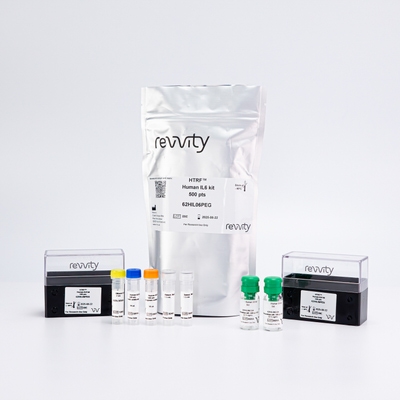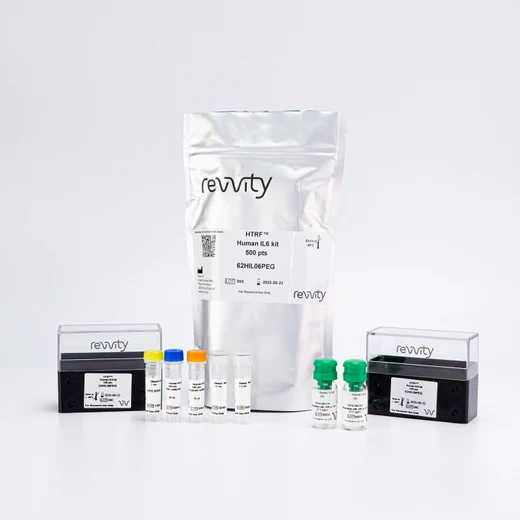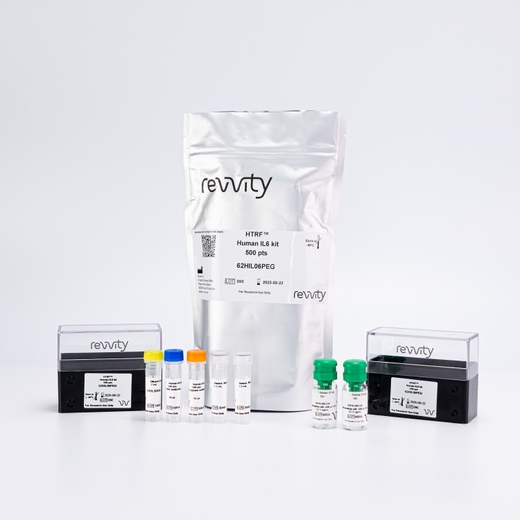

HTRF Human IL-6 Detection Kit, 500 Assay Points


HTRF Human IL-6 Detection Kit, 500 Assay Points






The HTRF human IL6 kit is designed for the quantification of IL6 release in cell supernatant.
| Feature | Specification |
|---|---|
| Application | Protein Quantification |
| Sample Volume | 16 µL |
The HTRF human IL6 kit is designed for the quantification of IL6 release in cell supernatant.



HTRF Human IL-6 Detection Kit, 500 Assay Points



HTRF Human IL-6 Detection Kit, 500 Assay Points



Product information
Overview
IL6 is a pro-inflammatory cytokine involved in acute-phase reaction, inflammation, and cancer progression. Secreted by T cells, macrophages, and fibroblasts, it induces B and T cell proliferation. It is being studied in a wide variety of research areas including diabetes, Alzheimer's disease, depression, and several cancers. Along with TGF beta, IL6 is main promoter of T cell differentiation into TH17, a new component of immuno-oncology.
Assessment of serum samples often requires enhanced sensitivity. In some cases, AlphaLISA assays may have sufficient sensitivity to enable detection of low levels of analytes in serum or plasma.
Specifications
| Application |
Protein Quantification
|
|---|---|
| Brand |
HTRF
|
| Detection Modality |
HTRF
|
| Product Group |
Kit
|
| Sample Volume |
16 µL
|
| Shipping Conditions |
Shipped in Dry Ice
|
| Target Class |
Cytokines
|
| Target Species |
Human
|
| Technology |
TR-FRET
|
| Therapeutic Area |
Metabolism/Diabetes
NASH/Fibrosis
Neuroscience
Oncology & Inflammation
|
| Unit Size |
500 assay points
|
Video gallery

HTRF Human IL-6 Detection Kit, 500 Assay Points

HTRF Human IL-6 Detection Kit, 500 Assay Points

How it works
Assay principle
Cell supernatant, sample, or standard is dispensed directly into the assay plate for the detection by HTRF® reagents (384-well low-volume white plate or Revvity low-volume 96-well plate in 20 µl). The antibodies labeled with the HTRF donor and acceptor are pre-mixed and added in a single dispensing step, to further streamline the assay procedure. The assay can be run up to a 1536-well format by simply resizing each addition volume proportionally.

Assay data analysis
The 4 Parameter Logistic (4PL) curve is commonly recommended for fitting an ELISA standard curve. This regression enables the accurate measurement of an unknown sample across a wider range of concentrations than linear analysis, making it ideally suited to the analysis of biological systems like cytokine releases.
Assay details
Technical specifications of human IL6 kit
| Sample size | 16 µL |
|---|---|
| Final assay volume | 20 µL |
| Kit components | Lyophilized standard, frozen detection antibodies, buffers &protocol. |
| LOD &LOQ (in Diluent) | 8 pg/mL &34 pg/mL |
| Range | 34 7,500 pg/mL |
| Time to result | 2h at RT |
| Calibration | NIBSC (89/548) value (IU/mL) = 0,1 x HTRF hIL6 value (pg/mL) |
| Species | Human only |
Analytical performance
Intra and inter assay
Intra-assay (n=24)
| Sample | Mean [IL6] (pg/mL) | CV |
|---|---|---|
| 1 | 384 | 5% |
| 2 | 2522 | 3% |
| 3 | 8594 | 3% |
| Mean CV | 4% |
Each of the 3 samples was measured 24 times, and % CV was calculated for each sample.
Inter-assay (n=4)
| Sample | [IL6] (pg/mL) | Mean (delta R) | CV |
|---|---|---|---|
| 1 | 116.5 | 400 | 13% |
| 2 | 268 | 1805 | 10% |
| 3 | 3261 | 7834 | 2% |
| Mean CV | 8% |
Each of the samples was measured in 4 different experiments, and % CV was calculated for each sample.
Dilutional linearity
| Sample | Dilution factor | [IL6] expected (pg/mL) | [IL6] detected (pg/mL) | Recovery |
|---|---|---|---|---|
| 1 | 1 | - | 2015 | - |
| 4.3 | 469 | 489 | 104% | |
| 7.4 | 271 | 292 | 108% | |
| 10.7 | 188 | 210 | 111% | |
| Mean | 108% | |||
| 2 | 1 | - | 354 | - |
| 4.3 | 83 | 82 | 101% | |
| 7.4 | 45 | 48 | 94% | |
| Mean | 97% | |||
The excellent % of recovery obtained from these experiments show the good linearity of the assay.
Spike and recovery
| Sample | [IL6] added (pg/mL) | [IL6] expected (pg/mL) | [IL6] detected (pg/mL) | Recovery |
|---|---|---|---|---|
| 1 | 3250 | 4098 | 4103 | 100% |
Recombinant cytokine was added to a serum sample, and the response obtained from a standard curve was compared to the calculated expected values. The 100% of recovery observed validates the sample matrix used for this assay.
Assay validation
Inhibition of IL6 secretion in THP1 cells with JTE607
THP1 cells plated at 100 kcells/well were incubated for 18 h with increasing concentrations of JTE 607 in presence of 2 µg/mL LPS. 16 µL of supernatants were then transferred into a white detection plate (384 low volume) to be analyzed by the Human IL6 Assay.

IL6 secretion in PBMCs stimulated with LPS
PBMC were plated at 50, 100 and 400 kcells/well and stimulated for 18 h with increasing concentrations of LPS ( 0, 0.02, 0.2, 2 µg/mL). 16 µL of supernatants were then transferred into a white detection plate (384 low volume) to be analyzed by the Human IL6 Assay.

Resources
Are you looking for resources, click on the resource type to explore further.
Ask real blood for real responses
Fresh blood is the model of choice to study drug immunotoxicity and predict adverse effects...
PBMCs: Waste no more
There is no reason to waste precious, hard-to-obtain unused cells! This Technical Note shares our internal...
This guide provides you an overview of HTRF applications in several therapeutic areas.
Discover the cutting edge of neuroinflammation assay research
This literature review illustrates the possibilities and versatility...
Dive deeper into astrocyte cell research
The release of pro-inflammatory factors by activated astrocytes has been shown to be...
Cytokines play a vital role in both innate and adaptive immunity and are known for their ability to exert diverse functions on...
SDS, COAs, Manuals and more
Are you looking for technical documents related to the product? We have categorized them in dedicated sections below. Explore now.
- LanguageEnglishCountryUnited States
- LanguageFrenchCountryFrance
- LanguageGermanCountryGermany
- Lot Number14ALot DateAugust 1, 2027
- Lot Number13ALot DateJuly 26, 2027
- Lot Number09ELot DateAugust 22, 2025
- Resource TypeManualLanguageEnglishCountry-


How can we help you?
We are here to answer your questions.






























